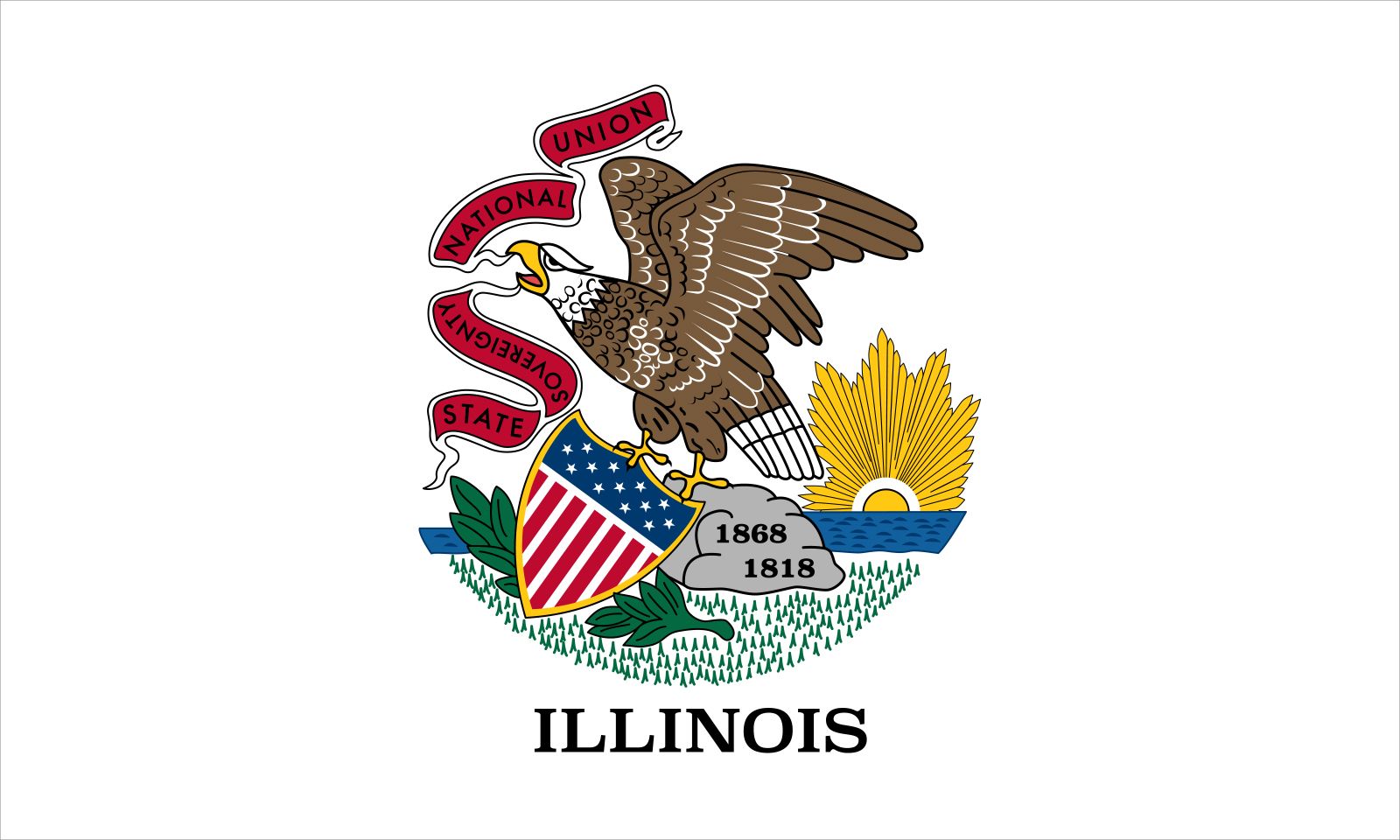
What makes the Illinois state flag unique? The Illinois state flag is a rich tapestry of history and symbolism, reflecting the state's identity and values. Adopted in 1915, it prominently features the Great Seal of Illinois on a white background. The seal showcases an eagle clutching a banner with the state motto, "State Sovereignty, National Union," along with the dates 1818 and 1868. This flag has undergone several changes, including the addition of the state's name in 1970 to ensure uniformity. Each element, from the eagle to the shield, carries deep meaning, symbolizing Illinois's commitment to both state autonomy and national unity.
The Design and Symbolism of the Illinois State Flag
The Illinois state flag is a powerful emblem that tells the story of the state's history and values. Let's dive into the design elements and symbolism behind this iconic flag.
-
Design Elements: The flag features the Great Seal of Illinois on a white background. The seal includes an eagle gripping a banner with the state motto, "State Sovereignty, National Union," and the dates 1818 and 1868.
-
Adoption: The first official state flag was adopted on July 6, 1915, after a campaign by Mrs. Ella Park Lawrence, State Regent of the Daughters of the American Revolution.
-
Original Design: The original design included elements from the state seal—a rock on a stretch of land with water and the rising sun behind it, plus a shield bearing the national stars and stripes in the claws of a bald eagle. A ribbon in the beak of the eagle bore the motto of Illinois, “State sovereignty—national union”.
-
Changes in Design: In 1970, the design was amended to include the state's name, "Illinois," underneath the seal in blue lettering. This change was made to ensure uniformity in reproduction of the design and color by flag makers.
-
Symbolism: The eagle represents the United States, while the shield in its talons symbolizes the original thirteen colonies. The banner in its beak carries the state motto, emphasizing Illinois's commitment to both state sovereignty and national unity.
Historical Context and Evolution
Understanding the historical context and evolution of the Illinois state flag helps appreciate its significance.
-
Seal History: The Great Seal of Illinois was originally designed in 1819 and emulated the Great Seal of the United States. The dates on the seal represent the year Illinois became a state (1818) and the year in which the Great Seal was redesigned (1868).
-
Motto Interpretation: The state motto, "State Sovereignty, National Union," reflects Illinois's position as a state within the United States while also asserting its autonomy and self-governance.
-
Flag Proportions: The flag of Illinois is designed to have a proportion of 3:5, which is standard for many state flags.
-
Color Scheme: The flag features a white background with the Great Seal of Illinois in the center. The seal includes specific colors for various elements such as water, land, rock, and sun, ensuring uniformity in production.
-
Flag History Survey: In a 2001 survey by the North American Vexillological Association, the Illinois state flag was ranked 49th out of 72 different flags of states and territories, mainly in the US and Canada.
Special Editions and Redesign Efforts
Over the years, special editions and redesign efforts have kept the Illinois state flag relevant and meaningful.
-
Illinois Sesquicentennial Flag: To mark Illinois' 150th anniversary of statehood in 1968, a special sesquicentennial flag was designed. This flag was dark blue with a stylized white letter "I" defaced with a red map of Illinois in the center, surrounded by twenty white five-pointed stars and an additional twenty-first star outside the circle to the upper-right.
-
Illinois Bicentennial Logo: Although there was no bicentennial flag, a logo was unveiled in preparation for the state's bicentennial in 2017. The logo featured a blue silhouette of the state with the word "ILLINOIS" above, a sunburst effect with the number "200" in gold, and the dates 1818 and 2018. Along the right side was the word "Bicentennial" in gold from bottom to top, surrounded by 21 gold stars denoting Illinois' position as the twenty-first state.
-
Flag Redesign Efforts: In March 2023, the Illinois Senate approved the Illinois Flag Commission to explore and develop a design for a new state flag. The Illinois House followed suit in May 2023, paving the way for a potential redesign in the coming years. By August 2024, it was announced that a contest to redesign the Illinois flag would open.
Influential Figures and Committees
Key individuals and committees have played significant roles in shaping the Illinois state flag.
-
Chief Petty Officer Bruce McDaniel: During his time in Vietnam, Chief Petty Officer Bruce McDaniel requested that the Illinois state flag be amended to include the state's name. This led to a bill being sponsored by Representative Jack Walker of Lansing and signed by Governor Richard B. Ogilvie on September 17, 1969, authorizing a new flag with the state's name.
-
Design Committee: Governor Ogilvie appointed a committee consisting of the State Historian, the Director of the Illinois Information Service, and the State Records Archivist to develop specifications for the new flag. Mrs. Sanford Hutchison of Greenfield, who had previously done extensive research on the official design of the state seal, submitted a design that was accepted by the committee, the Secretary of State, and the Governor.
Ensuring Uniformity and Symbolism
Efforts to ensure uniformity and symbolism in the Illinois state flag have been crucial.
-
Flag Manufacturers Guidelines: The Illinois Secretary of State issued design specifications to be followed by flag manufacturers and artists to ensure uniformity in production and color.
-
State Motto Meaning: The state motto "State Sovereignty, National Union" signifies that Illinois governs itself under the government of the United States while maintaining its autonomy and self-governance.
-
Eagle Symbolism: The bald eagle on the flag represents strength, freedom, and the United States as a whole. It is one of nine U.S. state flags to feature an eagle, alongside those of Iowa, Michigan, Missouri, New York, North Dakota, Oregon, Pennsylvania, and Wyoming.
-
Shield Symbolism: The shield in the eagle's talons symbolizes the original thirteen colonies, representing the foundation of the United States and Illinois's place within it.
-
Historical Significance: The Illinois state flag has been a symbol of the state's identity and history since its adoption in 1915. Its design reflects the state's commitment to both state sovereignty and national unity, making it a unique and meaningful emblem for Illinoisans.
The Illinois State Flag: A Symbol of Pride and History
The Illinois state flag, with its rich symbolism and historical significance, stands as a proud emblem of the state's identity. From its adoption in 1915 to the addition of the state's name in 1970, the flag has evolved while maintaining its core elements. The Great Seal of Illinois, featuring an eagle, a shield, and the state motto, encapsulates the state's commitment to both sovereignty and unity. Efforts to redesign the flag, including the recent establishment of the Illinois Flag Commission, show a continued dedication to preserving and enhancing this important symbol. Whether fluttering in the wind or displayed in a classroom, the Illinois state flag remains a powerful reminder of the state's heritage and values. Understanding these facts helps us appreciate the flag's role in representing Illinois's past, present, and future.
Was this page helpful?
Our commitment to delivering trustworthy and engaging content is at the heart of what we do. Each fact on our site is contributed by real users like you, bringing a wealth of diverse insights and information. To ensure the highest standards of accuracy and reliability, our dedicated editors meticulously review each submission. This process guarantees that the facts we share are not only fascinating but also credible. Trust in our commitment to quality and authenticity as you explore and learn with us.


